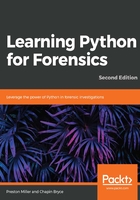
What this book covers
Chapter 1, Now for Something Completely Different, is an introduction to common Python objects, built-in functions, and tropes. We will also cover basic programming concepts.
Chapter 2, Python Fundamentals, is a continuation of the basics learned in the previous chapter and the development of our first forensic script.
Chapter 3, Parsing Text Files, discusses a basic setup API log parser to identify first use times for USB devices and introduce the iterative development cycle.
Chapter 4, Working with Serialized Data Structures, shows how serialized data structures such as JSON files can be used to store or retrieve data in Python. We will parse JSON-formatted data from the Bitcoin blockchain containing transaction details.
Chapter 5, Databases in Python, shows how databases can be used to store and retrieve data via Python. We will use two different database modules to demonstrate different versions of a script that creates an active file listing with a database backend.
Chapter 6, Extracting Artifacts from Binary Files, is an introduction to the struct module, which will become every examiner's friend. We use the struct module to parse binary data into Python objects from a forensically-relevant source. We will parse the UserAssist key in the registry for user application execution artifacts.
Chapter 7, Fuzzy Hashing, explores how ssdeep compatible hashes are generated and how to use the pre-built ssdeep module to perform similarity analysis.
Chapter 8, The Media Age, helps us understand embedded metadata and parse them from forensic sources. In this chapter, we introduce and design an embedded metadata framework in Python.
Chapter 9, Uncovering Time, provides the first look at the development of the GUI with Python to decode commonly encountered timestamps. This is our introduction to GUI and Python class development.
Chapter 10, Rapidly Triage Systems, shows how you can use Python to collect volatile and other useful information from popular operating systems. This includes an introduction to a very powerful Windows-specific Python API.
Chapter 11, Parsing Outlook PST Containers, demonstrates how to read, index, and report on the contents of an Outlook PST container.
Chapter 12, Recovering Deleted Database Records, introduces SQLite Write-Ahead Logs and how to extract data, including deleted data, from these files.
Chapter 13, Coming Full Circle, is an aggregation of scripts written in previous chapters into a forensic framework. We explore concepts and methods for designing these larger projects.